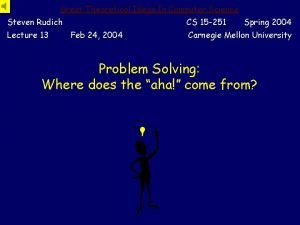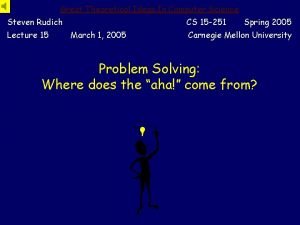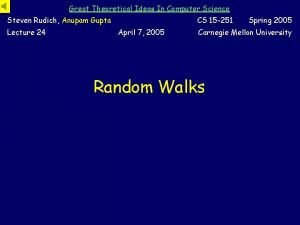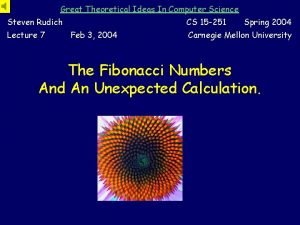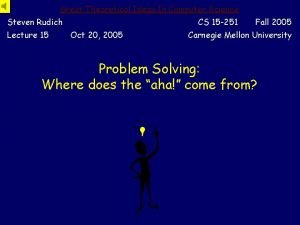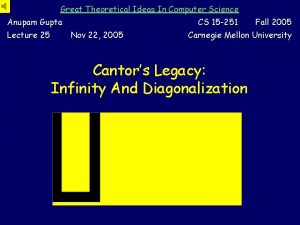15 251 Some Great Theoretical Ideas in Computer































- Slides: 31

15 -251 Some Great Theoretical Ideas in Computer Science for

Graphs II Lecture 18 (March 19, 2009)

Recap

Theorem: Let G be a graph with n nodes and e edges The following are equivalent: 1. G is a tree (connected, acyclic) 2. Every two nodes of G are joined by a unique path 3. G is connected and n = e + 1 4. G is acyclic and n = e + 1 5. G is acyclic and if any two non-adjacent points are joined by a line, the resulting graph has exactly one cycle

Cayley’s Formula The number of labeled trees on n nodes is nn-2

A graph is planar if it can be drawn in the plane without crossing edges

Euler’s Formula If G is a connected planar graph with n vertices, e edges and f faces, then n–e+f=2

Spanning Trees A spanning tree of a graph G is a tree that touches every node of G and uses only edges from G Every connected graph has a spanning tree

Finding Optimal Trees have many nice properties (uniqueness of paths, no cycles, etc. ) We may want to compute the “best” tree approximation to a graph If all we care about is communication, then a tree may be enough. We want a tree with smallest communication link costs

Finding Optimal Trees Problem: Find a minimum spanning tree, that is, a tree that has a node for every node in the graph, such that the sum of the edge weights is minimum

Minimum Spanning Tree 7 8 4 5 9 7 8 6 11 9

Finding an MST: Kruskal’s Algorithm Create a forest where each node is a separate tree Make a sorted list of edges S While S is non-empty: Remove an edge with minimal weight If it connects two different trees, add the edge. Otherwise discard it.

Applying the Algorithm 7 4 1 5 9 9 10 8 7 3

Analyzing the Algorithm The algorithm outputs a spanning tree T. Suppose that it’s not minimal. (For simplicity, assume all edge weights in graph are distinct) Let M be a minimum spanning tree. Let e be the first edge chosen by the algorithm that is not in M. If we add e to M, it creates a cycle. Since this cycle isn’t fully contained in T, it has an edge f not in T. N = M+e-f is another spanning tree.

Analyzing the Algorithm N = M+e-f is another spanning tree. Claim: e < f, and therefore N < M Suppose not: e > f Then f would have been visited before e by the algorithm, but not added, because adding it would have formed a cycle. But all of these cycle edges are also edges of M, since e was the first edge not in M. This contradicts the assumption M is a tree.

Greed is Good (In this case…) The greedy algorithm, by adding the least costly edges in each stage, succeeds in finding an MST But — in math and life — if pushed too far, the greedy approach can lead to bad results.

TSP: Traveling Salesman Problem Given a number of cities and the costs of traveling from any city to any other city, what is the cheapest round-trip route that visits each city exactly once and then returns to the starting city?

TSP from Trees We can use an MST to derive a TSP tour that is no more expensive than twice the optimal tour. Idea: walk “around” the MST and take shortcuts if a node has already been visited. We assume that all pairs of nodes are connected, and edge weights satisfy the triangle inequality d(x, y) d(x, z) + d(z, y)

Tours from Trees Shortcuts only decrease the cost, so Cost(Greedy Tour) 2 Cost(MST) 2 Cost(Optimal Tour) This is a 2 -competitive algorithm

Bipartite Graph A graph is bipartite if the nodes can be partitioned into two sets V 1 and V 2 such that all edges go only between V 1 and V 2 (no edges go from V 1 to V 1 or from V 2 to V 2)

Dancing Partners A group of 100 boys and girls attend a dance. Every boy knows 5 girls, and every girl knows 5 boys. Can they be matched into dance partners so that each pair knows each other?

Dancing Partners

Perfect Matchings Theorem: If every node in a bipartite graph has the same degree d 1, then the graph has a perfect matching. Note: if degrees are the same then |A| = |B|, where A is the set of nodes “on the left” and B is the set of nodes “on the right”

A Matter of Degree Claim: If degrees are the same then |A| = |B| Proof: If there are m boys, there are md edges If there are n girls, there are nd edges

The Marriage Theorem: A bipartite graph has a perfect matching if and only if |A| = |B| = n and for all k [1, n]: for any subset of k nodes of A there at least k nodes of B that are connected to at least one of them. Call a graph with this property No. Shrink. From(A)

No. Shrink. From(A)? For any subset of (say) k nodes of A there at least k nodes of B that are connected to at least one of them The condition fails for this graph

The Feeling is Mutual A At least k At most n-k B k n-k If it’s No. Srhink. From(A), it’s also No. Shrink. From(B)

Proof of Marriage Theorem Strategy: Break up the graph into two parts that are No. Shrink. From(A) and recursively partition each of these into two No. Srhink. From(A) parts, etc. , until each part has only two nodes

Proof of Marriage Theorem Select two nodes a A and b B connected by an edge Idea: Take G 1 = (a, b) and G 2 = everything else Problem: G 2 need not be No. Shrink. From(A). There could be a set of k nodes that has only k-1 neighbors.

Proof of Marriage Theorem a k b k-1 The only way this could fail is if one of the missing nodes is b Add this in to form G 1, and take G 2 to be everything else. This is a matchable partition!

Minimum Spanning Tree - Definition Kruskal’s Algorithm - Definition - Proof of Correctness Traveling Salesman Problem - Definition Here’s What You Need to Know… - Using MST to get an approximate solution The Marriage Theorem
 Great theoretical ideas in computer science
Great theoretical ideas in computer science Great theoretical ideas in computer science
Great theoretical ideas in computer science Great theoretical ideas in computer science
Great theoretical ideas in computer science Cmu 15251
Cmu 15251 Great theoretical ideas in computer science
Great theoretical ideas in computer science Great theoretical ideas in computer science
Great theoretical ideas in computer science Great theoretical ideas in computer science
Great theoretical ideas in computer science Great theoretical ideas in computer science
Great theoretical ideas in computer science Great theoretical ideas in computer science
Great theoretical ideas in computer science Great theoretical ideas in computer science
Great theoretical ideas in computer science Addressing mode in computer architecture
Addressing mode in computer architecture Cse 111
Cse 111 Cs 61
Cs 61 8 great ideas in computer architecture
8 great ideas in computer architecture 8 great ideas in computer architecture
8 great ideas in computer architecture 15-251
15-251 A vida tem tristezas mil
A vida tem tristezas mil Cs251 stanford
Cs251 stanford Anupam saxena
Anupam saxena Legge 251 del 2000 art 1
Legge 251 del 2000 art 1 Cs251 stanford
Cs251 stanford Aecp army
Aecp army Cs251 stanford solutions
Cs251 stanford solutions Aae 251
Aae 251 Cs 251
Cs 251 15-251
15-251 Graph theory cs
Graph theory cs Sometimes you win some
Sometimes you win some Sometimes you win some
Sometimes you win some Ice cream uncountable
Ice cream uncountable Force and motion
Force and motion Fire and ice diamante poem
Fire and ice diamante poem

